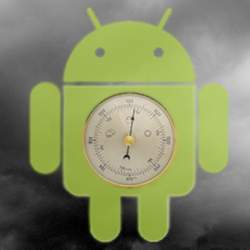
The advent of Global Positioning System-enabled apps on smartphones has revolutionized traffic data reporting. Motorists’ mobile devices automatically contribute by the millions each day to the stream of real-time map data that can help tell others where traffic is flowing smoothly and where delays have slowed things to a standstill.
Those same crowdsourcing capabilities now are emerging in weather forecasting, and pioneers of analyzing the data contributed by forecast-app-equipped mobile devices say the technology can be just as revolutionary as traffic data was.
Cliff Mass, professor of atmospheric sciences at the University of Washington (and “weather prognosticator/personality” for Seattle radio station KPLU, says, “This is a potential game changer, because there are a lot of these devices. There will be 50-100 million of these in the country in a few years,” generating “a lot of information.”
In fact, Mass says, “The future of weather prediction is this kind of very rapid, very frequent data collection and model integration. The National Weather Service just put online something that’s going in that direction, the High-Resolution Rapid Refresh, which has 3-kilometer resolution.”
The NWS platform, though, is updated only hourly, and the existing infrastructure of mainly static reporting weather stations, whether owned by public agencies, private forecasting services, or individuals who contribute the data to platforms such as Weather Underground, is scattered. The vast majority of weather apps for smartphones report only one-way data, from weather stations to handsets. The promise of two-way networks, of millions of individual smartphones contributing data at much smaller time intervals, could clue in meteorologists to the formation of severe convection (which can create tornadoes and other damaging weather phenomena) much more quickly; just as quickly, perhaps, as crowdsourced auto speed data shows a slowdown at the scene of an accident.
High Pressure, High Stakes
Unlike traffic data, however, there are significant restraints on the type of data that can be crowdsourced for weather prediction. Temperature data, for example, is unreliable; ambient temperatures may be 90o Fahrenheit or -20o Celsius, but if a phone feeding data is in an air-conditioned car or a heated house, the data it yields is useless.
According to Mass, the most reliable data to seek from a mobile-enabled network is barometric pressure; “every other parameter is useless, it makes no sense,” he says. “Pressure is absolutely unique.”
The number of phones with barometric pressure sensors is growing. Apple incorporated a barometer into the iPhone 6, the first iPhone to be so equipped. While numerous Android devices have had barometers for some time, Jacob Sheehy, CEO of Toronto-based Cumulonimbus, the developer of PressureNet, one of two barometric pressure-based forecasting apps currently available, says the Apple move was significant for the concept’s advancement (the other pressure-reporting app is WeatherSignal, developed by London-based OpenSignal, a company that crowdsources mobile network coverage for users and mobile operators).
“Apple has a way of making things mainstream whether we like it or not,” Sheehy says. “The news of the barometer is very important to me because it is market validation. I no longer have to answer questions about ‘what if they stop putting barometers in phones?’ It’s pretty clearly here to stay now.”
What is not clear is how or when the potential for phone-based pressure data will be put to greater use. For example, Sheehy says PressureNet, which launched in 2011, shifted its marketing strategy in mid-2013 because company executives realized they were not going to reach their user goals by targeting individuals. “We realized it was very unlikely that 10 million people would download our app,” he says. “And 10 million in this context is small, 100 million is really our goal here, and we’re not going to get there by people downloading PressureNet.”
To that end, the company has formed development partnerships with other emerging weather apps, such as Smart Thermometer from Palo Alto, CA-based Color Tiger. Sheehy says the PressureNet user base grows by 10-20 percent a month; it currently has 400,000 sensors in use. The platform’s data archives, stored on the Amazon Web Services cloud, stands at about 750 million atmospheric pressure measurements, growing by about 140 million readings a month right now.
There are two major issues with putting those to use, however. While trending data (whether pressure is rising or falling) is extremely reliable, Sheehy says exact pressure measurements are not, due to factors such as differences in altitude (the higher the altitude, the lower the barometric pressure, regardless of weather conditions) and sensor bias between handsets that could have smartphones adjacent to each other provide different readings.
The other issue, according to Mass, is that the still-nascent state of crowdsourced atmospheric pressure data is absent a player large enough to foster ubiquitous use of the data by major weather forecasting agencies, at least for now. “We need a much more omnipresent solution,” Mass says. “We need a really big app to collect the pressures, like Google Maps. I’ve contacted Google, and they haven’t been exactly enthusiastic. The engineers there are, but the management is not highly motivated at this point. If Google Maps collected the pressures while they were getting the speeds for cars, the problem would be almost solved.”
“I agree with Cliff that it will require one company really taking off, or a large existing company taking it up, as fragmented data from a number of small networks is not particularly useful,” says Samuel Johnston, brand strategist at WeatherSignal, which OpenSignal launched in 2013. “PressureNet’s answer is interesting as it involves putting the API in apps that are unrelated to weather–something that we have so far not done, as we believe that the best and fairest way to get users to participate is to tie the benefits of the app very closely to the direct benefits that the network as a whole will provide.
“However, we do feel that many users of the OpenSignal app would be extremely excited about what we’re doing, and so haven’t ruled out putting pressure data collection into OpenSignal, obviously with an option for users to disable it, which would boost our number of nodes worldwide from around 40,000 to almost 1.5 million.”
Sheehy says he has had discussions with Accuweather in the U.S. and The Weather Network in Canada, which is currently testing some of PressureNet’s data. One of Mass’s students recently conducted research that included readings using traditional data sources, and then added the crowdsourced PressureNet data. The study, published in the September 2014 Journal of the American Meteorological Association, showed the smartphone sensors contributed data that far more closely matched actual observed convection and precipitation than models using only traditional data sources.
“The best we can do now is get the data we can, run the models, and prove what it can do,” Mass says. “Once we show what the impacts are, once we have proof of the benefits, then it’s a political decision.”
Gregory Goth is an Oakville, CT-based writer who specializes in science and technology.



Join the Discussion (0)
Become a Member or Sign In to Post a Comment